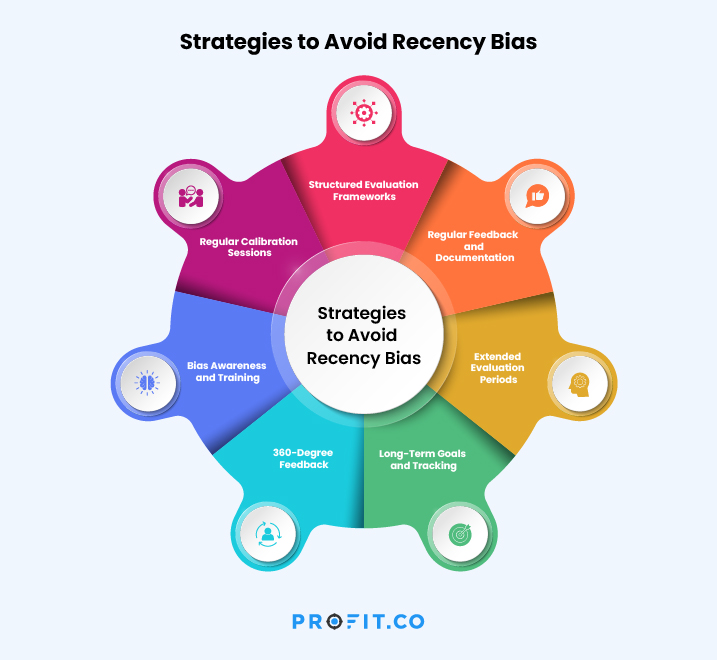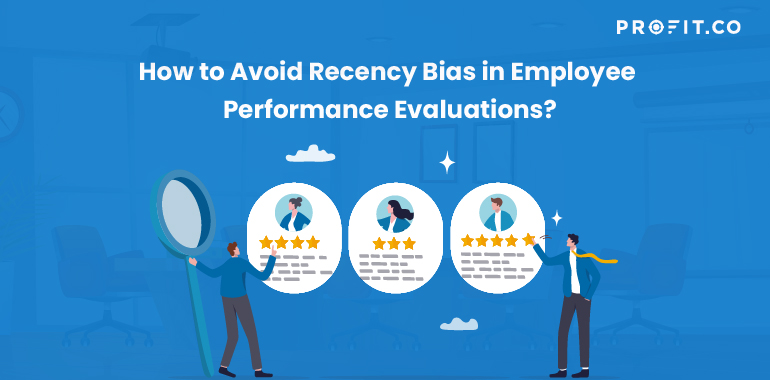Introduction
Recency bias happens when recent events get too much weight in employee evaluations. This can make your reviews unfair and inaccurate because it overlooks past performance. To create a fair and balanced process, it’s important to recognize accomplishments and areas for improvement throughout the entire evaluation period.
Luckily, you can implement effective techniques and strategies to avoid recency bias in employee evaluations. Let’s explore the definition of recency bias and thoughtful approaches that help ensure comprehensive and objective assessments reflect an employee’s true potential and performance.
The most basic probelm is that performance appraisals often don’t accurately assess performance
What is Recency Bias?
Recency bias means focusing too much on an employee’s recent achievements or challenges. Instead of looking at overall performance, our brains use the most recent information to make decisions. This can completely ignore past successes or struggles, ultimately leading to an unfair assessment.
Recency bias can prevent you from seeing the full picture. If you only focus on the last few months, you might miss the consistent progress someone has made over time, which can limit their professional growth.
One primary difference stands out when comparing the primacy effect to the recency effect. While we focus on the first available information in primacy bias, our brain focuses on recent information in recency bias.Since recency bias is mostly subconscious or unintentional, knowing its presence is the first step to avoiding its influence.
Recency bias can prevent you from realizing an employee’s growth potential. Focusing on recent events prevents you from recognizing consistent improvement and efforts. It can limit your ability to identify a person’s opportunities for growth within your company.Understanding the effects of recency bias helps you create objective and fair evaluation processes that nurture employee engagement and growth while benefiting your company.
In the following sections, we’ll highlight its risks and consequences while discussing actionable strategies to reduce its effects on a fair evaluation process that nurtures growth and development.
The Risks and Consequences of Recency Bias in Evaluations
The recency effect has a great impact on employee evaluation results. It emphasizes a person’s recent setbacks or achievements, overshadowing previous performance.
With this bias, you tend to disregard earlier challenges and accomplishments while prioritizing recent outcomes, interactions, and events.
Recency bias affects employee evaluations in several ways:
- Flawed Performance Data: If you only look at recent events, the data you use for reviews may be inaccurate. This can affect decisions on promotions, pay, and career growth.
- Unfair Evaluations: Employees may feel their progress over time is ignored, leading to evaluations that don’t reflect their true growth or potential.
- Lower Morale: When employees feel undervalued due to biased evaluations, their job satisfaction and engagement can drop.
- Missed Growth Opportunities: Focusing only on recent performance can prevent one from seeing an individual’s ongoing improvement and potential.
-
Can AI Think Like Humans? The Truth Behind AI Consciousness
Prakansha Charles Product Marketing Specialist Last updated: March 7, 2025 Artificial Intelligence (AI) has made remarkable strides in recent years,... Read more
-
5 Ways to Overcome Analysis Paralysis and Get Things Done
We’ve all been there. The mind starts swirling, the options start piling up, and before you know it, you’re staring... Read more
-
What is Democratic Leadership? A Complete Overview
Democratic leadership nurtures a positive work environment that motivates your team to perform better and succeed. Democratic leadership is successful... Read more
-
How Transactional Leadership Shapes High-Performance Teams
Transactional leadership empowers your team to perform better by instilling motivation through punishments and rewards. As a leader in any... Read more

Strategies to Avoid Recency Bias
Most companies struggle to eliminate bias, and most employees feel dissatisfied with performance reviews. As Christopher James Gilbert, author, and philosopher, resonates, understanding a person is not hard; the challenge is listening without bias.
Therefore, curbing bias in performance evaluations is vital to ensuring fairness and objectivity. You can effectively create balanced assessment processes by adopting strategies such as:
1. Structured Evaluation Frameworks
Use a structured framework for evaluations. This includes clear rating scales, performance metrics, and set criteria. Using a consistent method, you can avoid making decisions based on recent events alone.
Ready to create a fair and balanced performance review process?
2. Regular Feedback and Documentation
Encourage managers to give ongoing feedback throughout the year. Regular check-ins and documenting milestones provide a full view of performance instead of relying on the most recent weeks or months.
3. Extended Evaluation Periods
Don’t limit your evaluations to just the last few months. Look at a longer period to better understand the employee’s progress. This helps avoid focusing only on recent events.
4. Long-Term Goals and Tracking
Set long-term goals and track progress over time. This shifts the focus away from short-term performance and keeps attention on overall growth and development.
5. 360-Degree Feedback
Gather feedback from different sources, such as peers, supervisors, and team members. Incorporating varied perspectives will give you a well-rounded view of performance and reduce the chance of bias.
6. Bias Awareness and Training
Train your managers and evaluators about recency bias. Making them aware of it helps them identify and reduce bias during reviews.
7. Regular Calibration Sessions
Have managers come together to discuss employee evaluations and align their assessments? These sessions allow for different perspectives and help reduce individual biases, making evaluations more consistent.
Adopting these strategies empowers you to create a more objective and well-balanced evaluation process that relies on a person’s growth and performance. It becomes easier to nurture a culture of meaningful and fair performance evaluations, which results in more opportunities for professional development and higher employee engagement and satisfaction.
Tools and Techniques for More Balanced Evaluations
Eliminating recency bias in employee evaluations is vital for multiple reasons. In addition to promoting equity and fairness, it helps you foster an environment of equal rewards and opportunities while recognizing consistent efforts.
Reducing this bias comes with challenges that require conscious and proactive steps for continuous progress.
Here are some tools and actionable techniques you should adopt for an inclusive evaluation process. You need to use data and tools that support fair evaluations to reduce recency bias.
Here are a few ways to do this:
Replace Subjective or Vague Criteria with clearly defined rating or scoring scales.
Introducing a well-defined, specific, and clear rating scale in evaluations effectively avoids ambiguity in the appraisal process. Although performance reviews contain various assessment criteria, most ratings are not linked to specific and clear measures.
Looking at a recency effect example, an evaluation can inquire if an individual is a good communicator without offering practical benchmarks on which you can base the ratings. Instead of concrete measures, such open-ended remarks can trigger recency bias because leaders and managers rely on their ideas as benchmarks.
Overcoming this bias requires you to outline the particular demonstrable behaviors or indicators on which you’ll base evaluations. Depending on your assessment skills, ensure you have standardized evaluation forms or scorecards.
Use Data-Driven Tools and Frameworks in Decision-making
Technology can be invaluable in eliminating recency bias as it empowers you with tools for data-driven decision-making. With vital and innovative tools, such as Profit.co, it becomes easier to assess employees objectively based on long-term performance, broad experiences, and skills. Such a structured approach minimizes the influence of biases, preferences, and emotions.
Furthermore, you can integrate techniques such as SWOT analysis to evaluate every decision’s threats, opportunities, weaknesses, and strengths. You may also implement a decision matrix to help you score and rank various options depending on their weight and criteria.
Evaluate and Review Another effective technique to reduce recency error is evaluating and reviewing decisions and their impacts. Instead of making final decisions on a whim, measure and track the results and effects of those decisions.
Identify signals, indicators, and feedback loops that let you know whether your decisions work or not. Use failures and successes as learning opportunities, and reiterate and adjust as necessary to improve decisions.
Embrace Continuous Improvement
Overcoming recency bias and nurturing an objective and fair culture in a continuous process that requires commitment. It’s essential to reconsider and assess your evaluation processes while seeking feedback from evaluators and employees.
Doing so creates space for adjustments that help you align organizational needs with evolving best practices.
Address Skepticism and Resistance. Skepticism about recency bias elimination and resistance to change can hinder progress and the process. The best way to overcome this huddle is to encourage open communication and dialogue that highlights the advantages of fair evaluations for overall business or company success, employee engagement, and growth.
Offering success stories, clear explanations and including key stakeholders can enhance buy-in and prevent resistance. Recency bias plays a vital role in the accuracy and fairness of employee evaluations.
Conclusion
Exploring this concept and adopting effective tools and techniques for mitigation can help you implement a comprehensive and more objective appraisal process. Offering bias training and awareness, getting diverse feedback, using structured evaluation frameworks, ensuring regular feedback, and extending the assessment period are all actionable and effective ways to avoid recency bias. Once you address the challenge head-on, ensuring employee evaluations indicate a person’s true potential and performance will be easier At Profit.co, we understand the significant impact of unbiased and fair performance assessments. By leveraging our robust, innovative, and intuitive performance management solutions, you can easily ensure a culture of growth and transparency, mitigate bias, and streamline evaluation processes.

